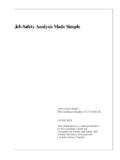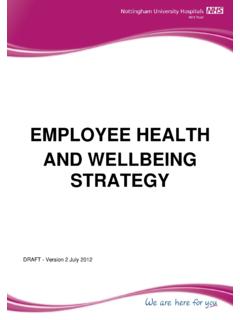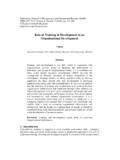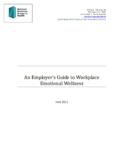Transcription of Canada Labour Code, Part II - Overview
1 Canada Labour code , part II - Overview Preface The purpose of the Overview of the Canada Labour code , part II, is to explain the legislation which applies to all areas under federal jurisdiction. This presentation designed for client education, will help to promote, through health and safety committees and health and safety representatives, self-regulation and the internal resolution of occupational health and safety-related complaints and problems raised by employers and employees. It will also help to establish a mechanism conducive to current affairs management and union participation. The basic role of Client Education and Training is to inform clients about proposed, new and existing programs provided by the Labour Program of Human Resources and Skills Development Canada . This role is rather broad and based on a certain number of needs that mesh well with the Program s requirements. These requirements are that clients be informed of new legislation and proposed legislation, new regulations and proposed regulations, and amendments to legislation and regulations, and clients be educated about requirements, benefits and rights under the legislation.
2 Description This is an information session on the Canada Labour code , part II, intended for employers and employees, members of health and safety committees and representatives who are covered by part II of the code . Purpose The purpose of the information session is: to provide information about the code as a proactive tool for reducing workplace accidents and occupational illnesses; and to identify the sections of the code that deal with the role of the participants in monitoring compliance. Methods The information session emphasizes participation and discussion, taking into account the participants and trainer s perceptions and experiences. The session includes a simplified presentation of the key provisions of part II of the code that have to do with occupational health and safety. During the session, information will be conveyed by means of a presentation and a group discussion. Introduction "Each year, many Canadians are killed or injured on the job. These tragedies have profound social repercussions and cost billions of dollars.
3 Knowing the Canada Labour code and, more importantly, applying the provisions of part II enables us to identify and correct problems that affect health and safety. It is one of the most effective ways to reduce accidents and occupational diseases in the workplace. The Canada Labour code applies to employees who work under federal jurisdiction, which encompasses about 10% of the Canadian workforce. They are employed in key sectors of the economy, notably air, rail and highway transport, pipelines, banks, broadcasting and telecommunications, uranium mines, marine transport and related services. Some 40 Crown corporations and agencies, indian reserves, and the entire federal public service are also subject to the code . Enforcement and administration of the Canada Labour code comes under the responsibility of the Labour Program of Human Resources and Skills Development Canada in partnership with Transport Canada and the National Energy Board. Transport Canada is responsible for on-board employees in the aviation, marine and rail sectors under federal jurisdiction, while the National Energy Board is responsible for employees in the oil and gas sector under federal jurisdiction.
4 " Subjects treated Duties of Employers Duties of Employees Work Place Health and Safety Committees Policy Health and Safety Committees Health and Safety Representatives Canada Occupational Health and Safety Regulations Three Basic Rights: Right to Know, Right to Participate, Right to Refuse Internal Complaint Resolution Process Health and Safety Officer Offences and Punishment Monthly Inspection Purpose of part II of the Canada Labour CodeUnder subsection , the purpose of the Canada Labour code , part II is to prevent accidents and injury to health arising out of, linked with or occurring in the course of employment to which this part applies. Under subsection , preventive measures should consist first of the elimination of hazards, then the reduction of hazards and finally, the provision of personal protective equipment, clothing, devices or materials, all with the goal of ensuring the health and safety of employees. Application Occupational health and safety legislation in the federal jurisdiction has been consolidated under part II of the Canada Labour code .
5 The code applies to the following interprovincial and international industries: banks; railways, highway and air transport; ferries, tunnels, bridges and canals; telephone and telegraph systems; pipelines; radio and television broadcasting and cable systems; shipping and shipping services; employment in the operation of ships, trains and aircraft; grain elevators licensed by the Canadian Grain Commission, and certain feed mills and feed warehouses, flour mills, and grain seed cleaning plants; federal public service and persons employed by the public service and about 40 Crown corporations and agencies; indian reserves; and exploration and development of petroleum on lands subject to federal jurisdiction. Note: part II of the Canada Labour code does not apply to certain undertakings regulated by the Nuclear Safety and Control Act. Duties of Employers Under section 124 of the code , employers have a general obligation or duty to ensure that the health and safety of every person employed by the employer is protected while they are working.
6 Also, under subsection 125. (1), employers have specific duties in regards to each work place they control and every work activity under their authority that occurs in a work place that is beyond the employer s control. Duties of Employees Under subsection 126. (1), the Canada Labour code , part II places several obligations on employees, all of which have the goal of preventing occupational related injuries and diseases. Employees have a responsibility to take all reasonable and necessary precautions to ensure their health and safety and that of anyone else who may be affected by their work or activities. Nobody knows a work place better than the people who work in it. part II of the code gives the work place parties a strong role in the identification and resolution of health and safety concerns. The provisions of the code are designed to strengthen employers and employees self-reliance to effectively deal with occupational health and safety issues and, in so doing, make work places safer.
7 Work Place Health and Safety Committees Work place health and safety committees must be established in work places where there are 20 or more employees. At least half of the committee members must be employees who do not have managerial functions. Each work place health and safety committee is required to meet 9 times a year, at regular intervals and during regular working hours. If circumstances make additional meetings necessary, they should be held during or outside regular hours, whatever is required. There are several powers and duties. The work place health and safety committee will: consider and expeditiously dispose of health and safety complaints; participate in the implementation and monitoring of programs for the prevention of work place hazards; participate in the development, implementation and monitoring of programs to prevent work place hazards, if there is no policy committee in the organization; participate in all of the inquiries, investigations, studies, and inspections pertaining to employee health and safety; participate in the implementation and monitoring of a program for the provision of personal protective equipment, clothing, devices, or materials, and, if there is no policy committee, participate in the development of the program; ensure that adequate records are kept on work accidents, injuries and health hazards; cooperate with health and safety officers.
8 Participate in the implementation of changes that may affect occupational health and safety, including work processes and procedures, and, if there is no policy committee, participate in the planning of the implementation of those changes; assist the employer in investigating and assessing the exposure of employees to hazardous substances; inspect each month all or part of the work place, so that every part of the work place is inspected at least once a year; and participate in the development of health and safety policies and programs, if there is no policy committee. The committee may request from an employer any information that it considers necessary to address work place hazards. It has full access to all government and employer reports, studies and tests relating to the health and safety of employees. Of course, it does not have access to an individual s medical records without the individual s consent. Policy Health and Safety Committees Policy health and safety committees must be established where an employer has 300 or more employees.
9 The intent of this committee is to take a more strategic approach to health and safety in an organization by dealing with global issues. The policy committee consists of at least two members. The employer appoints members in accordance with the following conditions. Half of the members of the committee are to be employees who do not exercise managerial functions. These members are to be selected by the trade union representing the employees. If the employees are not members of a union, then the employees at large will select their representatives on the policy committee. If a collective agreement allows, the membership of a policy committee may include people who are not employees. The policy committee will be led by two chairpersons. One will be selected by the employer members and the other by the employee members. Terms of office for committee members are not to exceed two years. There are several duties. The policy committee will: assist in the development of health and safety policies and programs; deal with matters raised by members and those referred to it by a work place committee or health and safety representative; participate in the development and monitoring of a program for the prevention of work place hazards, according to regulations, that also provides for the health and safety education of employees; participate in inquiries, studies, investigations and inspections as it considers necessary; monitor data on work accidents, injuries and health hazards; participate in the development and monitoring of a program, if any, for the provision of personal protective equipment, clothing, devices or materials; and participate in the planning of the implementation, and in the actual implementation, of changes that may affect health and safety, including work processes and procedures.
10 The policy committee has access to all government and employer reports, studies and tests relating to the health and safety of employees. It can request from the employer any information it considers necessary to identify existing or potential hazards with respect to materials, processes, equipment or activities in any of the employer s work places. The legislation requires that a policy committee meet at least quarterly during regular working hours. If additional meetings are necessary, the committee can meet during or outside regular working hours. Health and Safety Representatives In work places where there are fewer than 20 employees or in work places exempted from the committee requirement, there must be a health and safety representative. The employees of the work place who do not exercise managerial functions select, from among those employees, the person to be appointed health and safety representative. If the employees are represented by a trade union, then the union selects the person to be appointed, after consulting any employees who are not in the union.







